

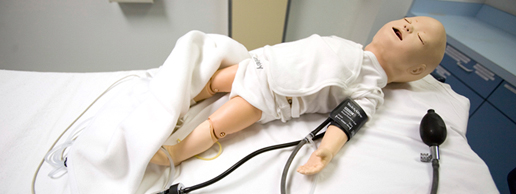
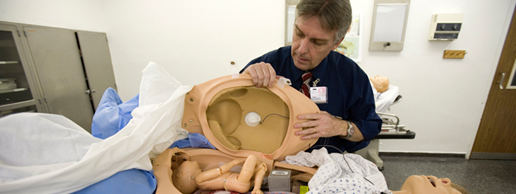
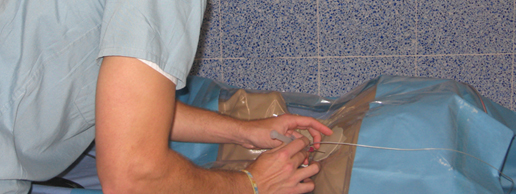
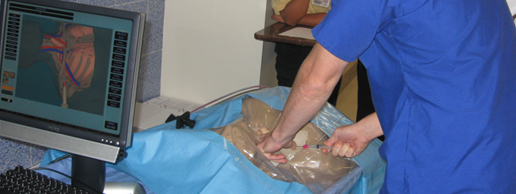
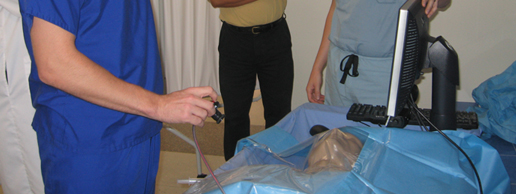
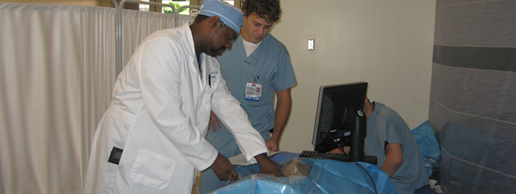
Technology Development
History
The University of Florida has a long and rich tradition of innovation in the development of simulation technology. The Center for Safety, Simulation & Advanced Learning Technologies (CSSALT) is at the forefront of technology development for simulation in healthcare. Researchers at CSSALT spearheaded mannequin patient simulator R&D in the mid-80's, developing what was to become the Human Patient Simulator (HPS) technology that is manufactured in Sarasota, FL and sold worldwide by Medical Education Technologies, Inc. (METI). When the web became stable and user-friendly in the late 90's, this tradition of innovation was sustained with the development of the web-enabled Virtual Anesthesia Machine (VAM) simulation and its namesake web site with an extensive portfolio of web-enabled simulations. Beginning in 2006, CSSALT started to develop mixed simulation applications.
Mannequin Patient Simulation
Development on what would become the Human Patient Simulator (HPS) began in 1987 at what is now CSSALT. The HPS went on to revolutionize how health care personnel are trained worldwide.
Mixed Simulation
Augmented Mannequin Patient Simulator
Standard mannequin patient simulators are "black boxes" Black boxes are an engineering term for a system where the input and output are visible and known but the internal structure function and process are unknown. For example, heart rate increases in response to administration of epinephrine but the linkage between the input and output is not made explicit. Augmented mannequin patient simulators provide a real-time visualization that is registered over the mannequin. This allows users to visualize how their actions and interventions alter internal processes and structure and function. Examples of augmented mannequin patient simulators (AMPS) currently under development are listed below.
This technology is available for licensing.
Contact Sem Lampotang at slampotang@anest.ufl.edu
-
Hypoplastic Left Heart Syndrome
Our first application of an augmented mannequin patient simulator uses the BabySim mannequin. The Babysim has been programmed with a scenario that reflects the physiological response of oxygen administration to a neonate patient with a congenital heart defect. Due to the patient's parallel circulation, oxygen dilates the pulmonary capillaries, reducing their resistance, resulting in more blood flow through the lungs with less going to the body. This is counter intuitive compared to a normal patient. We use an augmented reality visualization to provide the user with a mental model of the patient's unique physiology. video - (patent pending)
Augmented Anesthesia Machines
Anesthesia machines are also black boxes. The internal workings and gas flows are hidden to the user. They are life support systems and user error accounts for 75% of deaths or permanent brain injury associated with anesthesia machines. The augmented anesthesia machine uses a magic lens to overlay a registered transparent reality visualization over a corresponding part of an actual anesthesia machine. The anesthesia machine models that have been augmented are the Ohmeda Modulus II, Drager Apollo, and Drager Primus.
APOLLO / MOD II - (patent pending)
This technology is available for licensing.
Contact Sem Lampotang at slampotang@anest.ufl.edu
Augmented Procedural Trainers
Video of mixed simulation for ventriculostomy training - (patent pending)
This technology is available for licensing.
Contact Sem Lampotang at slampotang@anest.ufl.edu
Screen-Based and Web-Enabled Simulation
Mobile Devices
Pragmatic Precision Medicine: Race-Specific Propofol Model
iPad simulation of skin prepping
Instant Lap Skills Trainer with an iPad camera
(based on the trainer developed by Bahsoun et al)
Panoramic Simulations
An environment that surrounds a user can be readily simulated using a photorealistic panoramic scrollable interface that facilitates turning around in any direction. Users can interact with objects by clicking on their representation in the panoramic background or on thumbnails that are shortcuts. The interface can help novices become familiar with the layout of a real environment.
The video link below displays a UF demo version of a simulation that was developed for a drug manufacturer. The user plays the role of anesthesiologist in the simulation and takes a patient through a general endotracheal anesthetic from induction to emergence. The anesthesia providers' perspective of the patient, machine, drug cart, IV pole, airway cart, ceiling hung display and other equipment is preserved.
Video capture of a panoramic simulation - (patent pending)
This technology is available for licensing.
Contact Sem Lampotang at slampotang@anest.ufl.edu
Transparent Reality Simulation
Transparent Reality is a dynamic visualization technique where the internal structure and hidden or invisible processes are made visible. Abstract and invisible functions, processes and concepts are represented with explicitly visible and adjustable symbols to assist users in exploring, developing and confirming mental models. For example, gas flow is not only made visible but color coded via coloring and movement of gas molecule icons within the plumbing of an anesthesia machine. The flagship transparent reality simulation is the Virtual Anesthesia Machine (VAM).
Anesthesia machines are good examples of black boxes. The internal workings and gas flows are hidden from the user. They are life support systems and user error accounts for 75% of deaths or permanent brain injury associated with anesthesia machines. The VAM has been online free of charge since 1999. It has been translated into 23 languages and six medical gas color codes.
This technology is available for licensing.
Contact Sem Lampotang at slampotang@anest.ufl.edu
Web-enabled Simulation
There is a large portfolio of web enabled simulations here. These simulations are mostly anesthesia related and cover areas of anesthesia machines, pharmacokinetics, spinal anesthesia, drug uptake and distribution models, and anesthesia physics.
Many of these are available free of charge.
College of Pharmacy Simulations of PK
The College of Pharmacy has developed a curriculum that uses a set of online pharmacokinetic simulations.
Patient Safety Projects
Monitoring
Motion artifact vulnerability is generally regarded as undesirable during pulse oximetry. This pilot study examined the feasibility of exploiting induced motion artifact to identify response to verbal commands, for monitoring consciousness, for example, during procedural sedation or postoperative analgesia.
